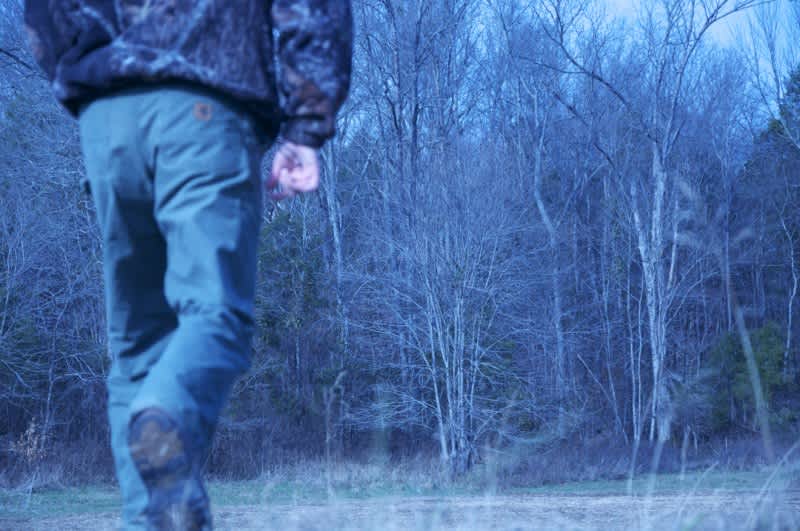Training for Turkeys: A Treatise on Woods Running
Josh Wolfe 03.06.14

Perhaps the title is a bit inappropriate, as you train for physical sport and you train for battle—turkeys, not so much. But it’s the best I can come up with for the time being, so that’s how it’ll remain. P90X and Crossfit Training have become extremely popular within our culture of do-gooders. What I can’t figure out is what exactly 99 percent of the population is “training” for. Perhaps the fifty emails they have to read on Monday morning?
Let me turn down the intensity by saying that being in decent shape for turkey season is pretty important. Imagine calling a hot bird. He’s coming and coming and then suddenly he’s not. Perhaps he’s reached a fence or creek he refuses to cross. Maybe the age-old tale about not being able to call turkeys down hills is in fact true. Regardless, the ball is in your court and it’s time to move—quickly and quietly.
When I’m tired I don’t give much thought to my movements, I just slog along until I reach point B. That’s not the way to treat turkeys, who have an acute sense of identifying sounds abnormal to their home woods (and there are no bears where I hunt). Southern Tennessee, where I spend the majority of the spring chasing turkeys, is very hilly—the foothills of the Appalachian Mountains. To help train my body and my mind for turkeys, I typically like woods running, which requires nothing more than a good pair of running shoes, pants, and a long-sleeved shirt. Not only does this kind of wild-man nonsense strengthen my lungs and legs, it also helps develop a heightened sense of awareness, what with branches, hidden logs, and low-hanging barbed wire clambering to slap and slash my face. When I take off from the house, I’ll cross a small field and enter the woods above a very steep bluff. The trick is to go for as long as you can, never stopping for any obstacle short of a 20-foot drop. I skirt the ridge and drop lower when the plane allows, heading towards the river and a more level path.
Going downhill is essential for proper training and can be very difficult. Downhill running is much faster and less controlled. Duck a branch and avert my eyes for too long and I’m liable to run into a tree or step in a hole—both of which have happened and will happen again. Important note: don’t attempt woods running at night, regardless of the moon phase.
My goal is to foresee the path of least resistance like a point guard driving down court, always remaining seven steps ahead of myself. On various occasions I have discovered unique facets of our farm that I did not know existed. For instance, just yesterday I was running up a creek bed that I knew to be perpetually dry, or so I thought. Upon closer examination I discovered that even though the tiny ecosystem was just a shell of its former self, the water dipped in and out of the ground in four different places within a 200-yard stretch as it wound back uphill into a cedar thicket. Laying by one deep pool (maybe a foot deep, but deep by little-creek standards) I entered into a Mexican standoff with a crawfish guarding his domain. The water tasted clean and then I was off.
As I start to ascend I certainly slow my pace to a soft jog. The uphill climb is long and rather steep in places. On the flipside, the path is clearer and branches don’t necessarily whip by my face any longer. I can see farther in front of me, though I try not to focus on the top. In my mind, it’s the negative receptacles that activate when such a daunting challenge is before me. Ignore. Ignore. Ignore.
But when I reach the pinnacle and turn back to see the rolling hills back to the Cumberland Plateau, I think what a stupid idea this whole thing was. My legs are wobbly and my lungs are on the verge of collapse, but perhaps my body is appreciative of the long-term effects. I’ll walk/jog for the half-mile back to the house, usually traversing a heavily-used deer trail running below a wheat field, because that’s the amount of “cool down” time I need.
In all seriousness, don’t be afraid to reach for your boy- or girlhood roots, answer the calling, if you will, when you ran through the woods whooping and hollering without a care in the world. Turkey hunting and everything surrounding it is for fun. Spring is on the way and soon the world will come back to life after a long winter—the dogwood’s bloom and the hummingbird’s arrival are two aspects of spring I look forward to each year. As of this writing (March 3) the wind has shifted out of the north and the temperature has fallen into the 20s. Freezing rain and sleet tap on the window, but my ears are alive with the old tom’s gobble, my heart rate increasing as the drumming gets closer…

